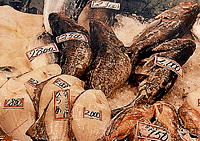I
have been to Kanazawa many times for work. Kanazawa
is a cozier town than Osaka. However, there are many restaurants
of quite a high standard, as well as many places where one can
observe the traditional handicrafts, so it is a very interesting
city.
In the city of Kanazawa there is a market called Omicho
Market. (Omicho Market is introduced in detail in
a separate section. Please take a look at this, too.) By going
to this market you can understand very well just how much the
Kanazawa people care about their food. One indication
of this is the amazing abundance of the ingredients arrayed in
the market. I was quite impressed. And the freshness of not only
the seafood, but also the vegetables, is also very significant.
For example, you can tell that the lotus roots have just been
dug up from the ground, as they are presented in the stalls with
the soil still on them. They are not like the clean lotus roots
that you see in the supermarkets. But if you were to ask me which
was tastier, I would have to say the lotus root with the soil
on it. This is proof that, when it comes to food, consumers here
place more importance on freshness and quality than appearance
and ease of preparation.
I think it is possible to judge how much the people of Kanazawa
care about their food from these indicators. And if the lotus
root is any indication of freshness, one can imagine how fresh
the seafood is.
So, why has cookery developed as it has in Kanazawa? I
have concluded that this is probably due to a combination of
a number of factors. Let me explain more clearly.
Firstly, this region is rich in ingredients. The large number
of restaurants and the abundance of ingredients available at
the markets is entirely due to the high quality of the seafood
and vegetables that can be obtained in the region. The life of
Japanese food exists in its ingredients. In fact, I think that
the success of a Japanese dish is ninety percent due to its ingredients
and ten percent due to the skill of the chef. Kanazawa
cuisine is created from the "goodness of the sea and fields".
The fields of Kaga are bathed in clear water from Shirayama,
one of Japan's three famous mountains, and yield good harvests.
The "goodness of the sea" is brought from the ports
of the Noto Peninsula, which juts out into the Japan Sea.
The second factor is Kanazawa's proximity to Kyoto.
You may wonder how much influence this could have, but it is
actually quite significant. Today, all cities of any size are
concentrated on the Pacific coast of Japan, and the Japan Sea
coast has become deserted. However, in the old days, it was quite
different. I remember learning from a textbook once, that the
Pacific coast is "the front of Japan", and that the
Japan Sea coast is "the back of Japan". But in old
times the Japan Sea coast was "the front of Japan".
Chinese and Korean culture entered Japan from the geographically
close Japan Sea coast and then spread throughout the country.
Records of archaeological excavations on the Noto Peninsula
clearly indicate that foreign cultures entered Japan in the Jomon
period (about 10,000 to 300 BC).
With the Japan Sea coast as the gateway to Japan, the Japan Sea
culture blossomed and was passed on to Kyoto. Kyoto,
as the capital, was the centre of Japan, so everything ended
up in Kyoto. Not only delicacies from all over Japan,
but also foreign cultures found their way to Kyoto. Foreign cultures
influenced even Japanese food, particularly through the introduction
of Buddhism. The exchange between Kanazawa and Kyoto,
therefore, had a great influence on Kanazawa cuisine.
Finally, there are the "traditional ingredients" of
Kanazawa, such as Kaga-fu (wheat gluten cake),
fish pickled in rice bran, fish sauce, Japanese confectionery
and so on. We call them simply "traditional ingredients",
but they are actually the embodiment of the knowledge of our
ancestors. Just the fact that these things have been handed down
over several hundred years is amazing. I suppose this is a manifestation
of the great value they placed on food.
There are probably other factors involved in the development
of cookery in Kanazawa, but I have mentioned just these
three.
Even now, some people are inclined to see Kanazawa as
a somewhat deserted, cozy town in the Hokuriku region.
But Kanazawa has a long and deep history, and when talking
about or studying Japanese cuisine it is a town that should not
be forgotten. Studying Kanazawa is perhaps equivalent
to studying the origins of Japanese cuisine.

